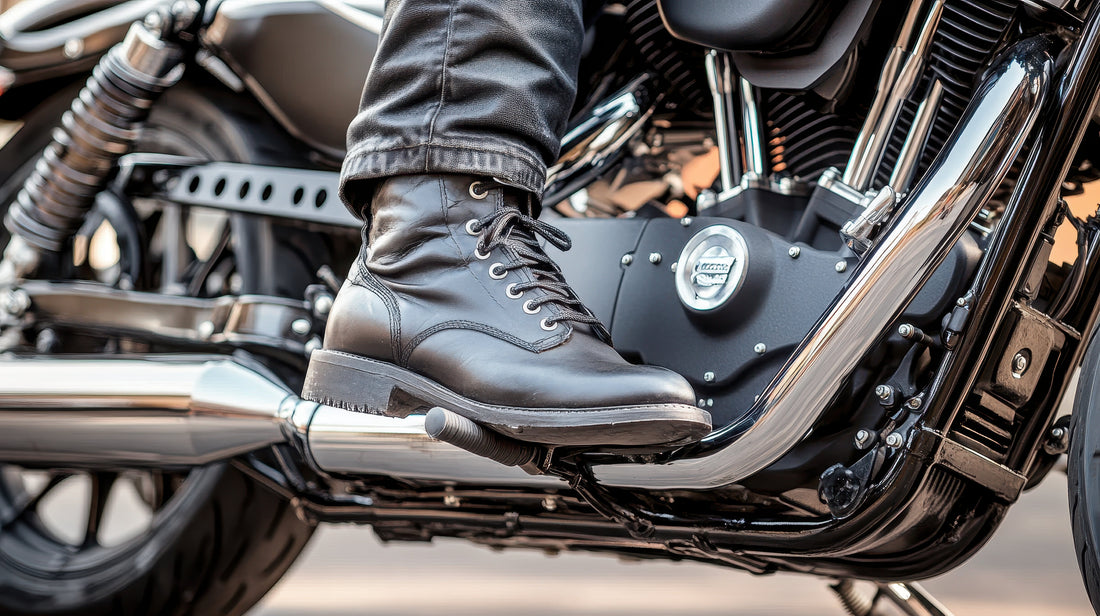Ever found yourself asking, “Are my boots really built for the road or just built for show?” You’re not alone. According to a detailed survey by the U.S. Department, "motorcycle riders are 28 times more likely to die in a crash than those in cars. In many of these cases, poor footwear can be a silent culprit." Instead of this, "nearly 40% of new riders still wear casual or non-certified boots, risking injury to ankles, toes, and heels during falls and collisions".
Experts point out, "What separates best motorcycle gear from regular gear or boots? A real riding boot resists twisting, protects impact zones, and actually stays on your foot in a crash."
So what should you look for? From CE rated armor and oil-resistant soles to fit, break-in periods, and the type of rider you are, this guide breaks it all down. Whether you are a commuter, tourer, ADV explorer or weekend warrior, this is your one stop roadmap to choosing motorcycle boots. They protect, perform and look the part. Let's explore it.
What Are Motorcycle Boots and Why They Matter?
Motorcycle boots are different from simple footwear. They are made from thick leather or synthetic materials. We incorporate impact armor, reinforced ankle structure and specially designed soles. According to experts, key features include reinforced toe and heel cups, stable ankle support and durable construction meant to withstand abrasion.
GearChic adds that motorcycle boots are engineered to stay on and protect in a crash unlike work boots which may fail completely at 10–15 mph.
CE Certification:
For riders in Europe and many global regions, CE certification under EN 13634 is essential. Boots undergo serious testing, such as abrasion, impact, penetration, and torsional resistance. A Level 2 rating (“2222” or “22BWR” stamped on the outsole) indicates superior protection, especially vital for highways and long touring.
This certification offers peace of mind: real-world safety backed by lab-tested credentials.
Key Features That Define a Quality Boot

Protection Zones
Look for reinforced toe and heel areas, ankle support, and shin coverage. Experts focus on these features, including internal armor or TPU inserts, which help guard vulnerable areas in a crash .
Sole and Grip
Good motorcycle boots have oil-resistant soles and a rigid shank to prevent ankle twisting during a low-side fall. Grip and pedal control are crucial to safe riding .
Comfort and Fit
Comfort means a snug fit that remains comfortable after a 100–200 mile break-in. Experts suggest models to stay snug all around the ankle with heel hold and no excessive sliding .
Closure Systems
Secure closures, such as zips, buckles, or lace-lock, help boots stay in place during extreme maneuvers or crashes .
Weather Adaptability
Look for waterproof membranes (Gore Tex and Sympatex) or breathable linings or removable liners. These protect your feet in rain or heat .
Matching Boots to Your Riding Style

Urban/Commuter
Low to mid-height with CE Level 1–2, side zip for convenience, slip-resistant soles, and comfortable for walking.
Touring
Mid to high boots with waterproof liners, ventilation, reinforced shanks and strong soles.
Adventure/Off-Road
Tall, buckle-closed, ankle-braced boots with stiff shanks and waterproof protection.
Sport/Racing
CE Level 2 race boots with shift pads, toe sliders, and rigid ankle support.
Comparison Chart:
|
Riding Style |
Height |
Protection Level |
Key Features |
|
Urban/Commuter |
Ankle–Mid |
CE 1–2 |
Side zip, slip sole, walking-friendly fit |
|
Touring |
Mid-High |
CE Level 2 |
Waterproof, reinforced shank, ventilation |
|
Adventure/Off-Road |
High |
CE Level 2 |
Buckles, ankle brace, rugged outsole, waterproof |
|
Sport/Racing |
High |
CE Level 2+ |
Shift pad, toe slider, composite protectors |
Real-World Rider Feedback
In famous communities of the internet, riders emphasize the importance of reinforced shifter pads, solid ankle structure, and CE certification, but overwhelmingly stress that perfect fit comes first.
Breaking In Your Boots
GearChic’s break-in tips are invaluable: your boots might feel tough at first, but after several rides, they soften. Start with snug fit at purchase, then break-in while riding, not walking.
Price and Value
High-quality motorcycle boots fall in the $150–$400 range, offering a balance of protection, comfort, and durability . Low quality choices sometimes slow down the CE rated protection or Framework stability
Final Thoughts:
Best motorcycle gear for men, best motorcycle gear for women, and good shoes for motorcycle riding are a vital component of your motorcycle gear ensemble. They protect, support and serve you mile after mile.
Remember to look for CE certification, secure fit, solid protection and weather readiness while deciding what motorcycle boots should I buy? You are investing not just in comfort but in safety and confidence on every journey with the right pair.











